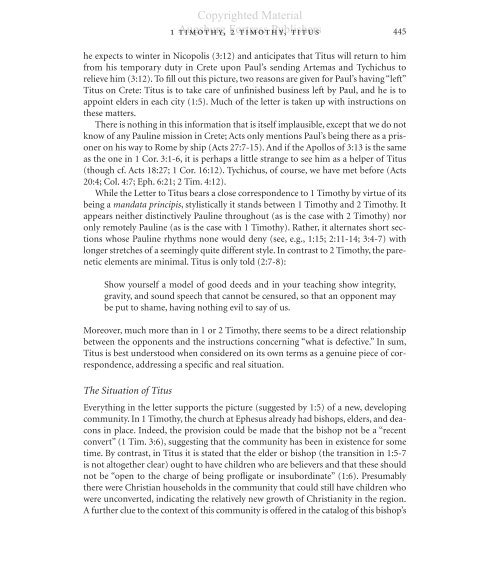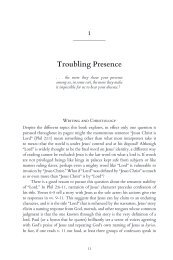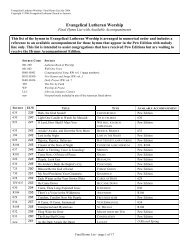19. Pastoral Letters: 1 Timothy, 2 Timothy, Titus - Augsburg Fortress
19. Pastoral Letters: 1 Timothy, 2 Timothy, Titus - Augsburg Fortress
19. Pastoral Letters: 1 Timothy, 2 Timothy, Titus - Augsburg Fortress
You also want an ePaper? Increase the reach of your titles
YUMPU automatically turns print PDFs into web optimized ePapers that Google loves.
Copyrighted Material<br />
1 <strong>Augsburg</strong> timothy, <strong>Fortress</strong> 2 timothy, Publishers titus 445<br />
he expects to winter in Nicopolis (3:12) and anticipates that <strong>Titus</strong> will return to him<br />
from his temporary duty in Crete upon Paul’s sending Artemas and Tychichus to<br />
relieve him (3:12). To fill out this picture, two reasons are given for Paul’s having “left”<br />
<strong>Titus</strong> on Crete: <strong>Titus</strong> is to take care of unfinished business left by Paul, and he is to<br />
appoint elders in each city (1:5). Much of the letter is taken up with instructions on<br />
these matters.<br />
There is nothing in this information that is itself implausible, except that we do not<br />
know of any Pauline mission in Crete; Acts only mentions Paul’s being there as a prisoner<br />
on his way to Rome by ship (Acts 27:7-15). And if the Apollos of 3:13 is the same<br />
as the one in 1 Cor. 3:1-6, it is perhaps a little strange to see him as a helper of <strong>Titus</strong><br />
(though cf. Acts 18:27; 1 Cor. 16:12). Tychichus, of course, we have met before (Acts<br />
20:4; Col. 4:7; Eph. 6:21; 2 Tim. 4:12).<br />
While the Letter to <strong>Titus</strong> bears a close correspondence to 1 <strong>Timothy</strong> by virtue of its<br />
being a mandata principis, stylistically it stands between 1 <strong>Timothy</strong> and 2 <strong>Timothy</strong>. It<br />
appears neither distinctively Pauline throughout (as is the case with 2 <strong>Timothy</strong>) nor<br />
only remotely Pauline (as is the case with 1 <strong>Timothy</strong>). Rather, it alternates short sections<br />
whose Pauline rhythms none would deny (see, e.g., 1:15; 2:11-14; 3:4-7) with<br />
longer stretches of a seemingly quite different style. In contrast to 2 <strong>Timothy</strong>, the parenetic<br />
elements are minimal. <strong>Titus</strong> is only told (2:7-8):<br />
Show yourself a model of good deeds and in your teaching show integrity,<br />
gravity, and sound speech that cannot be censured, so that an opponent may<br />
be put to shame, having nothing evil to say of us.<br />
Moreover, much more than in 1 or 2 <strong>Timothy</strong>, there seems to be a direct relationship<br />
between the opponents and the instructions concerning “what is defective.” In sum,<br />
<strong>Titus</strong> is best understood when considered on its own terms as a genuine piece of correspondence,<br />
addressing a specific and real situation.<br />
The Situation of <strong>Titus</strong><br />
Everything in the letter supports the picture (suggested by 1:5) of a new, developing<br />
community. In 1 <strong>Timothy</strong>, the church at Ephesus already had bishops, elders, and deacons<br />
in place. Indeed, the provision could be made that the bishop not be a “recent<br />
convert” (1 Tim. 3:6), suggesting that the community has been in existence for some<br />
time. By contrast, in <strong>Titus</strong> it is stated that the elder or bishop (the transition in 1:5-7<br />
is not altogether clear) ought to have children who are believers and that these should<br />
not be “open to the charge of being profligate or insubordinate” (1:6). Presumably<br />
there were Christian households in the community that could still have children who<br />
were unconverted, indicating the relatively new growth of Christianity in the region.<br />
A further clue to the context of this community is offered in the catalog of this bishop’s




